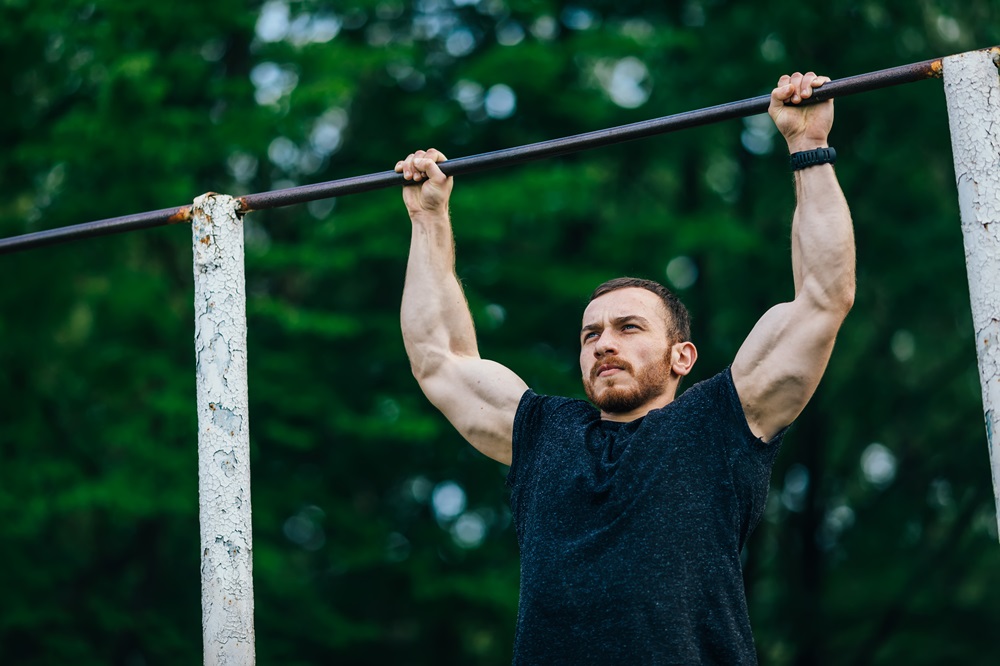Pull-Up Training – What Are the Benefits of Pull-Ups?

Pull-ups are one of the fundamental exercises that can help develop both upper body strength and endurance. This type of physical activity strengthens muscles and can be done at the gym, at home, or outdoors. It may seem like a simple exercise, but it requires mastering proper technique. How can you learn to do pull-ups? Which muscles work during pull-ups? How should you perform them?
Table of contents
Pull-ups - what are they?
Pull-ups are a compound exercise that engages many muscle groups at once. This form of physical activity involves lifting your body using a bar. It is a type of strength training that uses your own body weight. This exercise demands proper technique and can be quite a challenge for beginners.
Pull-ups - which muscles do they work?
Pull-ups focus mainly on the upper body, so the arms and back do most of the work. However, the abs, biceps, forearms, and chest are also involved. This means that pull-ups require the engagement of muscles such as:
- trapezius muscle
- latissimus dorsi
- biceps brachii
- abdominal muscles (rectus and obliques)
- shoulder girdle muscles
- pectoralis major
- infraspinatus muscle
Since different pull-up variations can target different muscles, it’s worth changing your technique regularly. This helps ensure balanced muscle development, even engagement of muscle groups, and a well-shaped physique.
Pull-ups - results. What are the benefits?
Pull-up training can bring many benefits. Regularly practicing this exercise can improve overall body functionality and increase upper body strength.
In addition, pull-ups can boost endurance, help build muscle mass, and contribute to shaping the physique. What’s more, consistent pull-up training can strengthen muscles, improve posture, and support fat loss.
Pull-ups - how to start? How to learn?
Pull-ups are one of the most challenging strength exercises, requiring proper technique. Your results can also depend on muscular endurance and neuromuscular coordination.
When starting pull-ups, don’t get discouraged if you can only manage one or two, or even none at all. Practice makes perfect, so it’s best to begin with resistance exercises like push-ups to strengthen your muscles, then move on to beginner-friendly pull-up methods.
A good first step is dead hangs, gradually increasing the time you can hang from the bar. Then try pulling your body without bending your arms, and later move to negative pull-ups, focusing on lowering your body slowly. This helps your body adapt to the movement.
Assisted pull-ups with a resistance band can also be helpful, as they make the concentric phase easier. Another option is using a pull-up machine or doing Australian pull-ups, where your body position differs from standard pull-ups, reducing the load from the lower body and making it a great choice for beginners to progress.
How to start doing pull-ups? Types of grips
Pull-ups can be done in several ways, each engaging muscles differently. The most common types are:
- underhand grip pull-ups - you grab the bar from underneath so you can see your palms. Compared to overhand pull-ups, this grip is stronger and engages the biceps more.
- overhand grip pull-ups - you grab the bar so that your palms face the ground. This variation works the forearms more and, according to professionals, requires greater training awareness.
- neutral grip pull-ups - the simplest variation, where your palms face each other.
Pull-ups can also be classified by grip width:
- narrow grip - hands no more than 20 cm apart,
- medium grip - hands about shoulder-width apart,
- wide grip - hands set far apart, putting more load on the lats.
How to perform pull-ups
A well-chosen grip, commitment, and proper technique are key to achieving good results. Pull-ups have three main phases:
- starting position at the bottom,
- pull-up position,
- top position.
In the starting position, keep your back engaged and arms straight, with shoulders slightly tense. Make sure your shoulders, collarbones, and muscles around your shoulder blades are tight. Moving into the pull-up phase, pull your shoulder blades down and together, bringing your elbows toward your ribs. Engage your abs and avoid swinging your body. When your chin passes above the bar, move into the top position. Here, squeeze your shoulder blades and, if possible, pull a bit higher, keeping your abs and glutes tight. It’s also important that your arms don’t end up in front of the bar at the top.
Pull-ups - how often to train? How many is a good result?
Beginners should focus on proper technique rather than the number of repetitions, as quality matters more than quantity in pull-ups.
Athletes who prioritize pull-ups should train regularly, ideally 2-3 times a week, with rest days for recovery. The number of reps and sets depends on the individual’s abilities, goals, and expectations.
It’s generally accepted that when you can do 12 pull-ups in one set, it’s worth adding modifications to make the exercise harder, such as using extra weight during your pull-ups.

